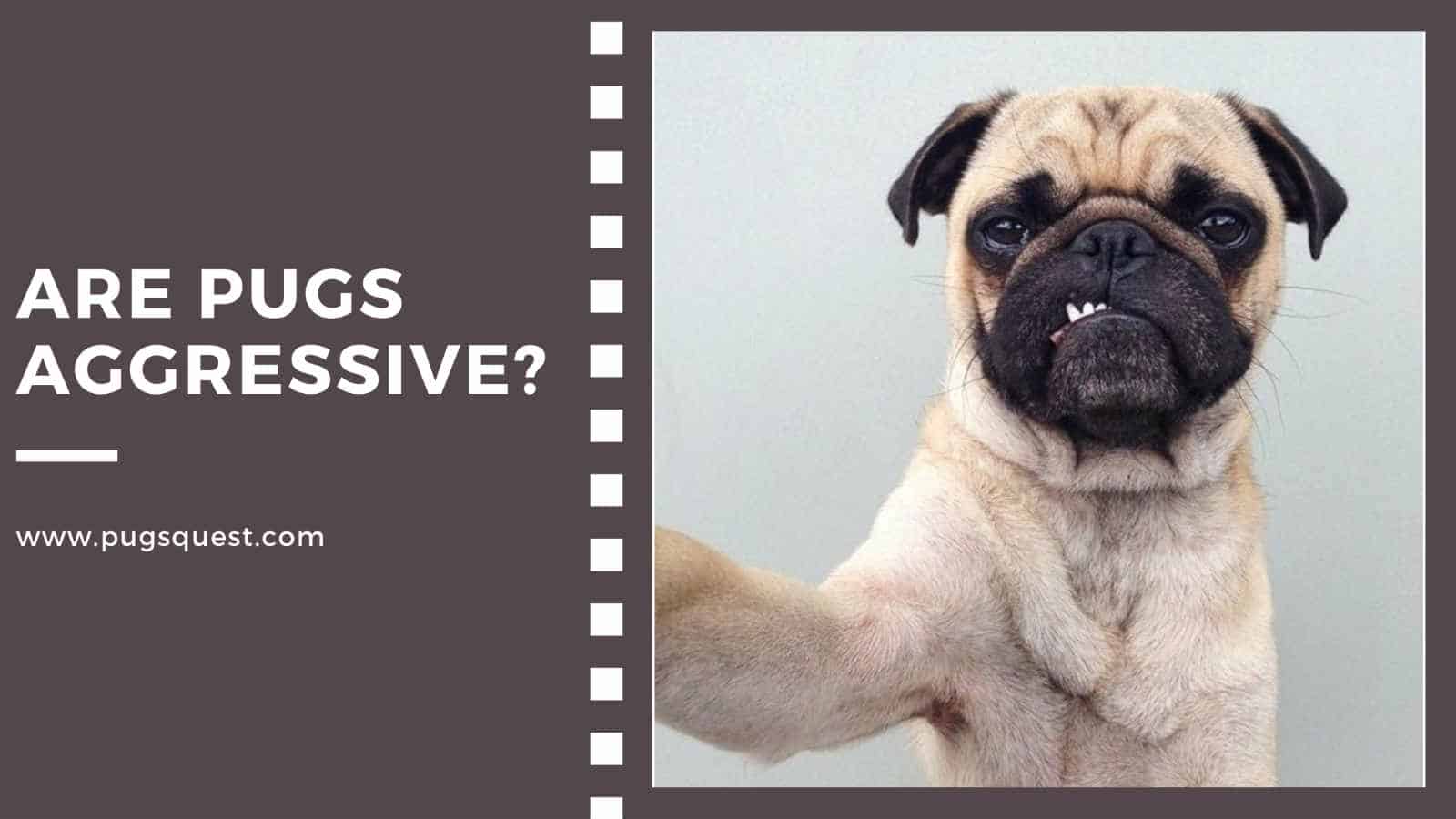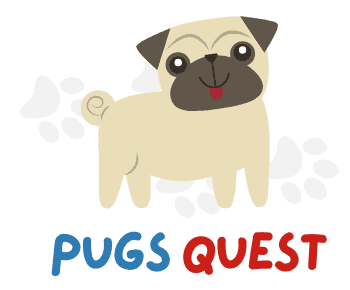
And whilst for the most part, this is true, it’s important to remember that even Pugs are capable of aggression given the right circumstances.
In this article, we’re going to discuss the ins and outs of aggressive behavior in Pugs to help you spot it, prevent it, and stop it.
Are Pugs Aggressive?
Pugs are well known for model temperaments. Friendly, funny, loving (need I go on?) But Pugs are not immune from aggression. Just like any other breed a Pug can, and will, demonstrate aggressive behavior in some circumstances.
We’ll talk more about this later.
The best way to frame Pug aggression is like this.
The Pug breed is (in general) not prone to aggressive behavior. But your Pug is an individual.
And as an individual, they have their own history, temperament, health issues, and genetic makeup. Whilst most Pugs have hearts of gold, this is not a universal rule.
Let’s take a look at some examples:
- Example 1 – Pugs with animals
In general, Pugs are great with other dogs, cats (and most pets for that matter). But some Pugs might act differently around unfamiliar animals.
- Example 2 – Pugs with new people
Pugs are well known for being great with adults, children, and seniors alike. But some unsocialized Pugs might become scared (possibly aggressive) with strangers.
Signs of Pug Aggression: What To Look Out For
We tend to think we know our pets inside out. Sometimes it’s all too easy to forget that Pugs aren’t people.
What do I mean by this?
Pugs communicate their aggression differently. It’s important that we get to know the common signs of aggressive behavior in Pugs to keep us, them, and the people around us safe at all times.
Common signs of Pug aggression include:
- Biting or nipping
- Barking more than normal
- Chasing animals
- Growling
- Lunging
- Bossiness
If you notice any of these behaviors, it could be a sign that your pet is starting to feel aggressive. This is your Pug telling you to back off.
Give them some space and de-escalate the situation to prevent any more dangerous behaviors.
What Causes Pug Aggression?
Don’t let all this talk of Pug aggression worry you. Remember (and we want to stress this point ‘till the cows come home) Pugs are not typically aggressive animals.
In fact, they have been bred as docile companion animals for thousands of years.
But as responsible pet owners, it’s in our best interest (and the best interests of our beloved pets) to be prepared for any situation that might come our way. Pugs are loving companions but each has a unique temperament, history, and set of circumstances.
With that in mind, let’s talk about what causes aggression to manifest in some Pugs.
1. Lack of socialization
This is a biggie.
Pugs aren’t born as domestic angels. They need to be socialized from puppyhood. Insufficient socialization is one of the best ways to encourage poor behavior in your dog.
Pups need to be hand-reared with love and care from birth. This gets them used to human touch, smells, and sounds. It also replaces any aggressive instincts, replacing them with desired social behaviors.
At this very delicate stage of a Pug’s life, any violence, aggression, or abuse inflicted upon them by a person or other animal will not be forgotten and this puppy is more likely to develop aggressive behaviors as it grows and develops.
Likewise, a pup’s new home will also shape its character. If their new owner is hostile or neglectful, that pup is going to protect itself as best it can.
2. Past trauma triggers
We’ve all heard of rescue dogs suffering from anxiety or PTSD due to past trauma. This is a real phenomenon and a major cause of aggressive behavior in dogs. Any dog that is exposed to trauma in their past is vulnerable to behavioral change.
It could be an isolated event or the culmination of abuse over time. Typically Pugs develop these emotional problems after being exposed to violent or abusive home lives. They become fearful, and aggression develops as a learned self-protection response.
3. Poor health or injury
We all act a bit differently when we’re feeling unwell or are in pain. Aggression is one possible symptom. And Pugs are just the same.
If your Pug starts to demonstrate aggressive behaviors out of the blue, contact your vet immediately.
It is often a sign that something isn’t quite right. They may be in significant pain or discomfort. Pugs can’t talk so this is their way of telling us something is wrong.
4. Dominance
Pack dominance is well ingrained in a dog’s genetic makeup. Now, nobody’s trying to compare a Pug to a German Shepherd here, but hear me out.
Whilst dominance is usually pretty low-key in the Pug world, in some instances this could be what’s causing your Pug to act aggressively.
The best way to avoid this is to nip it in the bud before it even becomes a problem. Assert yourself as the alfa of the pack (even if it’s just the two of you).
5. Food
Did you fight over food with your brothers and sisters growing up? If you did, I bet it got pretty intense from time to time. Nobody wants to give up that last slice of oh-so-delicious chocolate cake.
It’s fine to admit it. We all get snarky over our favorite foods from time to time. And our Pugs are no different.
If you’re a Pug owner already, I’m sure you’re well acquainted with the Pug’s insatiable appetite. They are big foodies.
Food aggression is a well-known phenomenon in the dog world. Dogs are genetically programmed to protect this precious resource.
After all, they don’t know you’ve got three months’ worth of bulk-buy doggy biscuits in the garage and another trip to Costco on the agenda.
Think of it that way and, actually, we could say that their behavior is more justified than ours.
So there we have it. Though it’s unlikely, there are a variety of reasons why a Pug might become prone to aggression. Other possible aggression triggers include:
- Genetics – if they were bred from aggressive parents
- Age – increased risk of health problems and dementia
How To Prevent Pug Aggression
We’ve talked about the problem so let’s get down to a solution.
The best way to treat Pug aggression is to prevent Pug aggression.
That means training, training, training.
We cannot stress enough the importance of training for your Pug’s behavioral and emotional health. With proper training, exercise, and lots of TLC your Pug will have no need to use unwanted behaviors around you or your family.
So what exactly should we be doing?
1. Obedience training
Obedience training might sound like a hassle, but believe me when I tell you it’s worth it. You’ll thank your past self for putting in the effort when you have a perfectly behaved Pug by your side.
Obedience training is based on simple commands and behavior training. It is designed to give you as the dog owner more control over your pet’s behavior.
At the end of the day, this creates a safer environment for owners, canines, and the general public who will encounter the dog on a daily basis.
So, what are some obedience training techniques?
- Positive reinforcement
To prevent aggressive behaviors from developing in an otherwise, well-behaved, animal, use positive reinforcement to encourage desired behaviors. Since Pugs are so food-motivated, using a favorite treat as a reward is sure to go down well.
- Distraction
Food can also be used as a distraction method. Distract your Pug from undesirable behaviors with a firm command. Let your Pug reflect then redirect their attention with a treat.
- Time-out
This classic Supernanny technique isn’t just for kids. It works wonders for Pugs too. If your Pug displays aggression put them in a designated ‘time-out’ spot. Your pooch will soon learn that aggression leads to serious boredom.
Finally, when it comes to obedience training your Pug, keep these top tips in mind:
- Start early – It’s easier to prevent bad behavior than to fix it
- Be patient – Pugs are not the smartest cookies on the block
- Be consistent – Your Pug will know you mean business
2. Social training
We’ve already stressed the importance of proper socialization for healthy puppy development. Without socialization training, a Pug is at greater risk of developing unwanted, or aggressive behaviors. And they’re not to blame.
Without socialization, they haven’t developed the knowledge or skills necessary to live side by side with people. They may fear humans, resulting in defensiveness. Likewise, when pups are removed from the litter prematurely they miss important developmental milestones.
When we break it down, socialization is just common sense. Socializing a litter involves:
- Raising pups in a comfortable, clean, warm environment
- Giving pups healthy food and access to clean water
- Keeping pups with mom Pug and litter for no less than 8 weeks
- Playing with, talking to, and bonding with the pups
- Keeping pups in a calm, stress-free environment
- Exposing pups to other animals and people
Ideally, Pug pups should be socialized by the breeder. But it’s still good practice to continue socialization training once you bring your puppy home.
If you don’t have friends or family with other dogs to socialize with, try a dog park or daycare. Plus don’t forget the importance of introducing your new pup to lots of new people.
What If Nothing Seems To Work?
If despite your best efforts, nothing seems to be working and your Pug still acts in an aggressive way for no apparent reason, we would always recommend making an appointment to see your vet. It could be that your Pug is suffering from a medical condition that you simply cannot see.
If your Pug is in pain, then treating this pain should eradicate any aggressive behaviors. If there is no medical cause, then it’s advisable to bring in the services of a trained animal behaviorist for advice and specialist training techniques.
Keeping Pugs Aggression At Bay
With the proper care and training, there is absolutely no reason why your Pug should develop aggressive traits.
Being aware of the early warning signs is the best prevention.
Are Pugs aggressive?
By nature, no. But, just like us, life can take its toll on them. A pug that is in pain, or struggling with trauma is more likely to resort to aggression.
Image from pinterest
